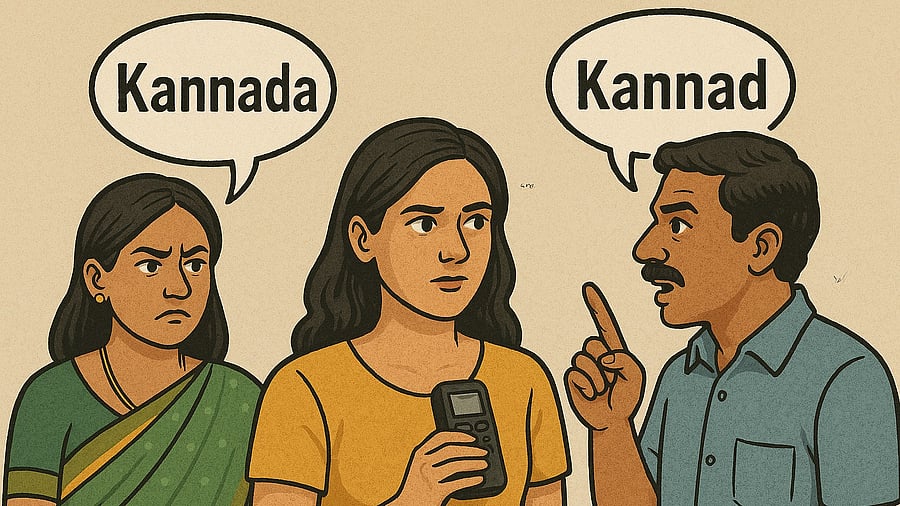
A major contention in Karnataka language politics has been how North Indians pronounce the word ‘Kannada’. Today, the phrase Kannad gottilla, is being reappropriated to invoke a sense of linguistic pride and further the discourse around language in the state. DH spoke to linguists to understand how North Indians came to say ‘Kannad’ instead of ‘Kannada’.
Linguists believe that the speaker’s primary language has an influence on other spoken languages too. This is known as first language interference.
Meti Mallikarjuna, linguist, professor, and researcher at Kuvempu University, explained that linguistic structures are different for different languages. “Kannada and other Dravidian languages are largely vowel-based, which means the words end with a vowel. Whereas some languages like Hindi end with a consonant sound,” he said.
As a result, speakers unfamiliar with vowel-ending languages may struggle with correct pronunciation. Many Hindi words end with consonants — pustak (book, pustaka in Kannada), ganith (mathematics, ganitha), chintan (think, chintana).
“When a speaker borrows a word from another language, they will make certain changes in the pronunciation. This is because certain sounds may be found in one language but not the other. There may also be other reasons. For example, the structure of the borrowed word may be different from what the speaker is exposed to in their primary language. This is the reason why North Indians refer to our language as 'Kannad',” says D N Shankara Bhat, a linguist.
Even when native Tamil speakers converse in Kannada, they form sentences using Tamil grammar, said Sabiha, an academician and former professor of Kannada. “These grammatical rules of the primary language are deeply rooted. Many speakers are only able to adapt to the grammar of a second language when they speak it as much as their primary language,” she shares.
Is 'Kannad', then, technically wrong?
Bhat explained that it is not necessarily wrong since such adjustments are common. Native English speakers make a distinction between “v” and “w”, but most Indians do not. “We even write the word 'English' in Kannada with a retroflex fricative (sh written as ಷ್, recognised in the International Phonetic Alphabet as ʐ, which is absent in the English language). Where did this sound come from?” he questioned.
Some Kannadigas also may say ‘hujband’ instead of ‘husband’, noted Mallikarjuna. “There will always be variations in how a language is spoken. The mispronunciation may not be deliberate. They are perhaps not aware of it, or there is nobody to correct them,” he explained.
Sabiha says there are two ways to view a language. “One is how grammarians look at it. Their method is prescriptive — based on rules. Linguists look at language as it is and analyse how and why it changes, and who changes it,” she explained.
Influence of other languages
Mallikarjuna observes how many Malayalam speakers have a different pronunciation when speaking another language. “Such adjustments are called intervocalics. For instance, when ‘pa’ is replaced with ‘ba’, ‘ka’ with ‘ga’, and so on. It is an influence of their native language on other languages. Many Urdu speakers say ‘ischool’ for ‘school’. This is because initial consonant clusters like ‘sk’ and ‘pr’ are rare in Urdu,” he added.
Similarly, when Kannada speakers speak Malayalam, they may not be able to pronounce all the words correctly. Mallikarjuna takes the word “pazham” (fruit) as an example. The “zh” is pronounced as a rolled ‘r’ (ɻ in the International Phonetic Alphabet), also known as a retroflex approximant. In Kannada, it may be pronounced as a retroflex “L” (ɭ in the IPA), or a retroflex lateral approximant.
Similarly, even Tamil is pronounced as "Tamizh," which many non-Tamil and Malayalam speakers have trouble pronouncing.
Taking Tulu speakers speaking Kannada as an example, Sabiha says that the retroflex “L” and retroflex nasal (ɳ) present in Kannada are absent in the Tulu language. “While speaking Kannada, Tulu speakers find it very difficult to identify these differences,” she noted.
In Kannada, there are 25 grouped consonants, while in Tamil, there are only 18. “The aspirated letters, also called mahaprana (gha, dha, jha), are absent in Tamil. So naturally, while speaking languages that have aspirated letters, the pronunciation will change,” Sabiha explained.
Official change necessary?
Sabiha noted that language is constantly evolving. “Change is a natural part of any language. As our experiences grow, new words emerge and older forms shift. There is no absolute right or wrong in how 'Kannada' is pronounced, even if some say 'Kannad',” she said.
Even official representations remain inconsistent. For instance, in the Republic Day tableaux, Karnataka is still ‘Karnatak’, Kerala is ‘Keral’, and Andhra Pradesh is ‘Andhr Pradesh’.
Despite this, it is mostly blue-collar workers within the state who are targeted for not speaking Kannada fluently or for mispronouncing certain words. This reflects how language politics can unfairly affect those with the least access to formal education or linguistic support.